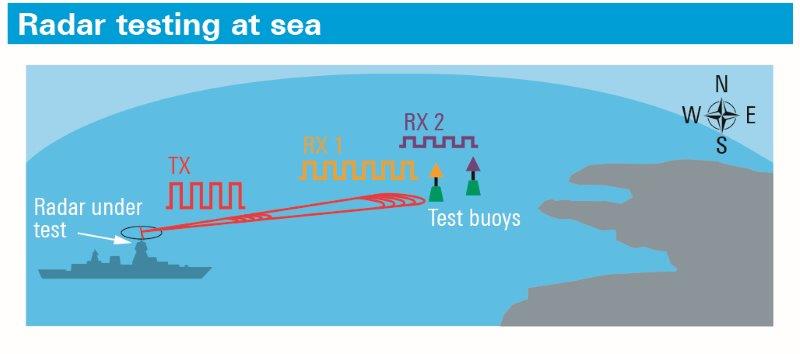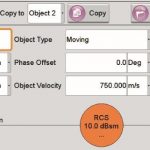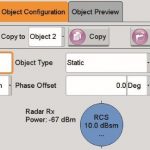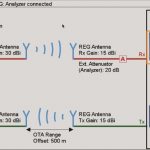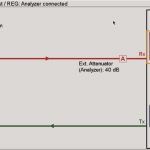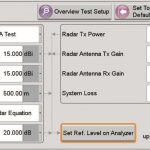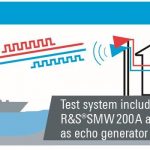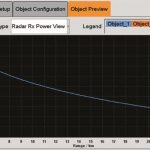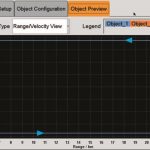A new software option simulates realistic radar echoes that can be used to comprehensively test radar systems. All that is needed is a signal generator and a spectrum analyzer.
Radars: proven reliability a must
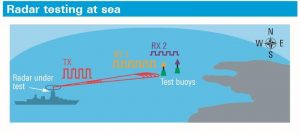
Fig. 1: Test scenario for determining the range resolution of a radar.
Radars, similar to optical systems, provide images of the surroundings. They use electromagnetic signals to illuminate their surroundings and then generate an image of the environment from the echoes returned by reflecting objects. Unlike optical systems, radars can also produce a situational image in the dark or where visibility is poor. Radars consist of several subsystems, including a transmitter, receiver and the radar processor, which calculates the situational image from the data received. The radar is set in the appropriate operating mode for the specific task and the radar processor sets the required parameters, such as the pulse duration and pulse repetition rate.
One of the typical requirements for navigation radars is to reliably detect the signal echo reflected by another ship from among the numerous disruptive echoes caused by waves, even in heavy seas. Since radar images are essential for navigation and reconnaissance, the systems must be extremely reliable. Ensuring reliability often requires extensive field tests in addition to standard laboratory tests (see box) – and these have to be repeated in every operating mode. Navigation radars, for example, have two separate modes for detecting close and faraway objects. All these tests take time and tie up resources, which is why manufacturers and operators always strive to minimize the effort involved.
- Fig. 2: Configuration of a static (top) and a moving object (bottom) on the R&S®SMW200A vector signal generator.
- Fig. 2: Configuration of a static (top) and a moving object (bottom) on the R&S®SMW200A vector signal generator.
Simulation software reduces testing effort
The R&S®SMW-K78 radar echo generation software option for the R&S®SMW200A vector signal generator enables users to artificially generate radar echoes. The R&S®FSW signal and spectrum analyzer is also needed as a radar receiver. This solution makes field tests largely unnecessary. The option can generate radar signal echoes in a realistic manner and provides all the prerequisites for conducted and over-the-air (OTA) tests. The generator controls the spectrum analyzer and configures it so that both devices appear to the user as a single system that is operated via the generator.
For pure receiver tests, the R&S®SMW200A can be used as an echo generator even without the spectrum analyzer. It generates the transmit signals in the digital baseband, e. g. using the R&S®Pulse Sequencer software (see article on page 33).
- Fig. 3: Conducted test (top) and OTA test (bottom).
- Fig. 3: Conducted test (top) and OTA test (bottom).
Realistic simulation of
radar echoes
The R&S®SMW200A generates radar echoes of static and moving objects at user-configurable ranges. It automatically sets the delay, the Doppler frequency and the RF output level for each object. For moving objects, the generator constantly updates the delay and the output level of the echo signal. This means, for instance, that the signal level of the echo of an object that is radially approaching the radar increases after each update. The algorithm is based on the radar equation and the propagation loss in free space. The generator can simultaneously produce up to a total of 24 static and moving objects.
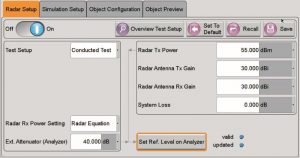
Fig. 4: Required parameters for configuring conducted tests.
The top section of Fig. 2 shows the menu for defining the objects used to create the echo signal. Static objects are assigned a specific range. Their size can be defined via the radar cross section (RCS). The R&S®SMW-K78 option models the point objects with a constant RCS, which is often called “Swerling 0” after the underlying RCS statistic.
For moving objects, the velocity and the start and end range to the radar can be specified (Fig. 2, bottom). The objects can be assigned a movement pattern, e. g. a one-way path from the start to the end location or continuous movement between the start and end location. Superposition of echoes can easily be simulated by mixing static and moving objects.
Handles many different
test cases
- Fig. 5: Basic test setup of an OTA test on a radar (right). Below is the menu for the required settings.
- Fig. 5: Basic test setup of an OTA test on a radar (right). Below is the menu for the required settings.
Radar engineers have to cope with numerous test cases and types. Typical system tests include confirming fixed target suppression performance for moving target indicator (MTI) radars and testing the minimum threshold for detecting an object. For a test system to be able to test whether a radar system can detect small objects near a large object, it must have a sufficiently large spurious-free dynamic range. By generating multiple echoes and several objects with different velocities, it can be demonstrated how well radars can simultaneously track, resolve and display these objects. Standard test approaches such as using optical delay lines only partially solve these issues. They are often not flexible, generally need intensive maintenance and also require other measuring equipment to perform all the tests. Thanks to its excellent RF characteristics and versatility, the R&S®SMW200A vector generator equipped with the R&S®SMW-K78 option can be used to perform a variety of tests – without a lot of equipment.
- Fig. 6: Live preview of the configured scenario containing a static and a moving object (top). Bottom: Calculated echo signal level versus time.
- Fig. 6: Live preview of the configured scenario containing a static and a moving object (top). Bottom: Calculated echo signal level versus time.
Conducted tests and OTA tests
For conducted tests, the radar signal is fed to the R&S®FSW via a cable. It is then downconverted, digitized in realtime and fed to the R&S®SMW200A (Fig. 3, top). The generator uses this signal to generate echo signals that are indistinguishable from real echoes. For OTA tests, the signals are received and transmitted by antennas that are connected to the input port of the analyzer and to the output port of the generator (Fig. 3, bottom).
Conducted tests
Conducted tests are ideal for development and final testing before radars are permanently installed on a platform. They significantly reduce the overall effort since tests that would only be possible fairly late, such as certification runs for navigation radar, can be carried out during development.
The software offers the option of manually configuring the radar receive level or using the radar equation to automatically calculate it based on the radar scenario. Fig. 4 shows all parameters (except the object properties and center frequency) that must be set in order to use the radar equation to automatically calculate the signal power level at the receiver.
OTA tests
If radars are already in operation and installed on a ship, for instance, then the effort to set up tests in the lab is excessively high. In such cases, functional tests have to be performed at sea. However, these take time and during this time the ship cannot be used. The Rohde & Schwarz solution makes it possible to perform comprehensive tests during normal port layovers. The setup consists of the R&S®FSW and R&S®SMW200A with antennas at the RF inputs and outputs (Fig. 5). The generator and the analyzer are installed in a stationary test system that receives the radar signals via a test antenna with known properties and returns the echoes to the radar under test. This test setup (Fig. 5) can be completely configured on the R&S®SMW200A if all relevant transmission path parameters are known (e. g. radar and test setup antenna gains and radar transmit power).
For this test case as well, it is possible to manually configure the radar receive level or use the radar equation to automatically calculate it based on the radar scenario. The required RF output power at the generator is automatically determined from the configured parameters so that the right echo level reaches the input of the radar receiver.
Example of a test scenario
A typical test scenario consists of two objects. Such scenarios can be easily simulated in the lab with the R&S®SMW200A. The parameters can be changed for variants. The top section of Fig. 6 shows a preview in the range /velocity view displaying the overall result of all configured reflecting object parameters. Object 2 (orange) is stationary at a range of 3.75 km from the radar. Object 1 (blue) moves a few kilometers away from the radar at a velocity of 750 m/s and returns. Before the tests are carried out, the user can check whether the scenario is properly configured.
The bottom section of Fig. 6 shows the level of the echo signal versus time calculated by the R&S®SMW200A. Echo 2 (caused by object 2) has a constant level and a constant time delay to the transmission pulses. Both the level of echo 1 (caused by object 1) as well as the time delay to the transmission pulses vary based on the range.
Summary
The new R&S®SMW-K78 option for radar echo generation saves time when testing prototypes in development as well as when servicing operational radar systems. The R&S®SMW200A signal generator together with the R&S®FSW signal and spectrum analyzer make it possible to perform conclusive radar tests that previously could only be made in time-consuming field tests after development was complete. The user does not have to invest in special solutions and the cost of lab equipment is reduced since the spectrum analyzer and vector signal generator are already on hand and can also be used for other measuring tasks.
Typical test scenario at sea
For certification tests, maritime radars are mounted on a ship and put into operation. The ship operates in a defined sea area in which objects with defined backscatter properties and backscatter power (mainly buoys) are placed. These are arranged so that it is possible to determine the most important radar properties such as the range resolution and the azimuth resolution.
The range resolution of a radar is its ability to recognize that two objects positioned behind each other at the same azimuth angle to the radar are separate objects. The radar under test transmits a pulsed signal and receives the echo signals from the two test buoys (Fig. 1). The difference in the delay times of both echoes is a measure for the geometric spacing of the two objects. If the system can separate the two echo signals from each other, the two objects will be displayed on the radar screen. If the range resolution is too low, only one object will be seen on the screen.
Determination of the azimuth resolution is similar. In this case, a check is made to see if the system can distinguish between two objects that are positioned at the same range, but at different azimuth angles to the direction the ship is traveling. This ability is mainly determined by the antenna characteristic.


